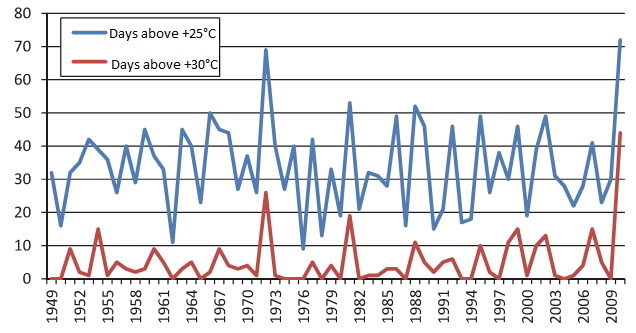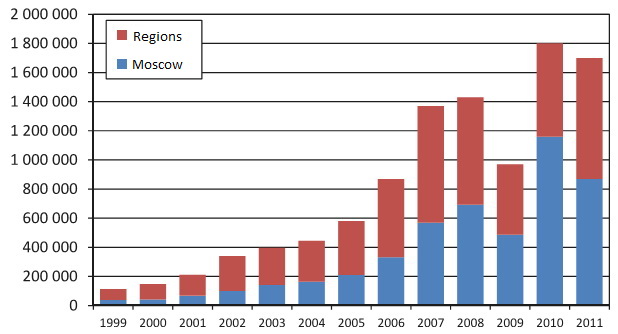What should we expect in the coming season?
The past season gave yet another evidence that air conditioner sales depend, first of all, on the weather. Summarizing the results of 2010, which was a record by sales volumes, many market players are preparing for the forthcoming season with some caution, expecting serious excessive stocks at the market. How reasonable are these expectations? To answer this question, it is necessary to analyze in detail the events of the past year, first of all—from the climatic point of view.

Thus, in 2010, the Russian market of split systems experienced sales boom due to the abnormal heat wave in the European regions of Russia. In Moscow, temperature above 30 °C was recorded during 44 days, of those—33 in a row. For reference: in past 60 years in Moscow there were only 260 days with temperature above +30 °Ñ, meaning that, on the average, there were only 4 or 5 such days each year.
The number of days with temperature above +25 °C and +30 °C in Moscow is shown in Diagram 1. It becomes clear, that temperatures above +30 °C are rare in Moscow, they are recorded even not each year, while the number of days with temperature above +25 °C is anywhere from 13 to 53 per year. Abnormalities similar to the past year’s occur once in about 35 years. Something similar happened in 1972 and, earlier, in 1938. It’s notable, that Diagram 1 sweeps away some very spread myths, for instance, the myth about the relatively cold summer of 1953. That year in Moscow was distinguished by a local maximum of temperature and was similar to the hot 2007.
As to the probability of reiteration of 2010, we need to look at a longer period of time (Diagrams 2 and 3). By all appearances, we’ll have to wait for a long time for a new great heat wave with doubled average summer temperatures to come again.

To see more clearly the exiting trends, let’s draw a plot showing change of summer daily average temperature during 11-year and 22-year periods (Diagram 3). Why 11 and 22 years, in particular? That’s simple. Astronomers noted long ago expressed cyclical character of the sun activity. The most famous cycle is 11-year one, and the next cycle by duration is 21.5 years. That is why it’s only logical to use these numbers. However, in principle, any other values could have been taken, as it would cause almost no changes to the behavior of the plots. One thing is obvious: the larger is the database for average value calculation, the smoother the line becomes.
The plot is very indicative. Three periods can be seen clearly on it. The first one, up to the end of the 30-s is notable due to the summer temperatures are consistently below the normal average calculated over the whole period of meteorological observations. During the second period, from the late 30-s up to the late 80-s, the temperature rises slightly above the average. And the third period that started in the late 80-s is notable due to the fast growth of summer temperatures. It’s very interesting to note that the periods seen on the plot coincide almost completely with so-called economic orders—strongly marked cycles in the development of the civilization tied to the introduction of technical innovations. Thus, from 1880 till 1940, electrification ran the show. The period from 1930 till 1990 is called the oil period, for good reason, while the period from 1980 and on is called the information age. The periods last 60 years each and overlap.
Thus, in 1985, when daily average temperature in summer reached the clear-cut minimum, the period of 50–60 warm summers started. Today, we are in the very middle of the cycle. This point is the point where the trend changes. There was a clear-cut minimum around 1913—the bottom of the cold period, and around 1961 there was a maximum, after which temperatures fell gradually for 20 years. It’s only reasonable to expect something similar in our time.

Forecasts by serious scientists say the same. We will take the liberty of providing the following extended quote: “Analysis of the solar activity conducted by The Central Astronomical Observatory of the Russian Academy of Sciences shows that the so-called ‘global warming’, which is used for threating the world community, coincided with the maximum of the so-called ‘solar constant’, which is, in simpler words, the energy flow measured in watts per square meter of the Earth surface. At that, the global warming at the end of the 20th century started not only on Earth, but on Mars as well: astronomers noted increased incidence of dust-storms, active melting of polar caps, and temperature increase. Today, the heat flow reaching our planet starts decreasing consistently. According to forecasts of astronomers, the planet will be balancing at the upper temperature point until 2012, after which the planet will start cooling down and, by 2042, the global average temperature is to fall by 1-1.5 degrees as the deep minimum of the solar activity is reached.” (A. Nikonov, Crises in the history of the civilization).
As for the forecast for the summer of 2011, the principle of 4-(8)-year cycle will be most adequate; this principle was discovered by us in 2004 and has proven to be useful till now. The principle states that during 4-(8)-year cycle, a half of summers are ‘hot’*, a quarter are ‘average’, and a quarter are ‘cool’. At that, hot years usually come in pairs. Thus, 2011 was preceded by ‘cool’ 2008, ‘average’ 2009, and ‘hot’ 2010. According to the principle, those are to be followed by ‘hot’ 2011 ending the four-year cycle. Afterwards, ‘cool’ or ‘average’ year is practically ‘must be’. (Three consecutive hot years during past 60 years occurred in Moscow only once, in 1966–1968).
Summarizing all the information, the following conclusions could be made:
- Today, we are in the middle of the abnormally warm 50–60-year period.
- Within the several years from now, the trend of growing summer temperatures is to change to the opposite, however, the change will be relatively smooth.
- In 2011, in European regions of Russia, a hot summer is expected, however, temperature records like those in 2010, are unlikely.
2011 SCENARIO

So, 2010 brought us abnormal heat due to which almost all air conditioners imported to the country, including even illiquid models stored at warehouses for many years were sold out by August, 15. And in the autumn of 2010, the demand was at the March’s level! The result was 86 % growth of the market in quantitative terms. In monetary terms, the growth was more modest—only 73 %—since the market growth was mostly due to small-power air conditioners. Growth in up to 5 kW segment was 95 %, while in over 5 kW segment it was only 25 %. In other words, the boom was mostly due to the customers living in city flats who were driven crazy by the unusual weather.
If the territorial structure of sales is analyzed, the outlook for 2011 is far from rosy. In 2010, sales in Moscow increased 2.4 times; Moscow accounted for more than 63 % of all sales! After such a boom, in 2011 the demand is most likely to fall back and the Moscow market is likely to show 20–30 % downward correction. Frightened by the hot 2010, Moscow citizens will actively purchase air conditioners in 2011 up to the middle or end of June. As a result, sales volume in the capital of Russia will be 15–20 % higher than in ‘wealthy’ pre-crisis 2008. However, this year is highly unlikely to reach the level of 2010. This will also be aggravated by the fact that about 17,000 split systems in Moscow were sold in September through December, that is, in the course of preparing for the summer of 2011. So, this year, we will be those 17 000 split systems short.
In 2010, growth in other Russian cities constituted 5–40 %, 25 % on the average. So, in 2011, even if the summer turns out hot and market growth in regions of Russia reaches 30–35 % (it’s a real figure if the deferred demand is taken into account), still sales volumes across the country as a whole will not reach the levels of 2010 (Diagram 4). Taking into account the volumes ordered for 2011 this is likely to result in huge stocks of unsold equipment. According to the most conservative estimates, there will be about half-million unwanted split systems, while the overall stock volume is likely to constitute 800,000 to 850,000 units.
The most interesting fact is that the weather of 2011, irrespective of its characteristics, will not be able to cause qualitative changes to the situation. Until June, the main factor driving sales of air conditioners will the memory of the past-year heat wave. After June, the understanding of the fact that there will be no abnormal heat in 2011, this sales driver will disappear. The actual warmth of the summer of 2011 may correct the overall sales volume within 200,000 units and slightly improve or worsen the situation with stocks. That is, even in most optimistic scenario, sales volume may reach 1,900,000 units, leaving about 600,000 units in stock.
Georgy Litvinchuk, Litvinchuk Marketing Agency General Director